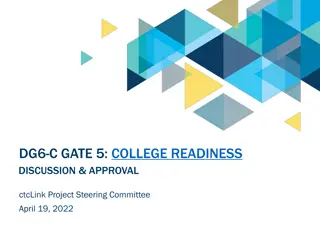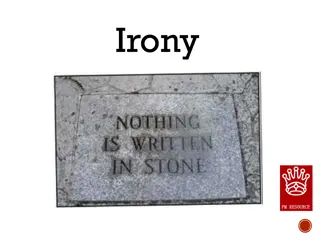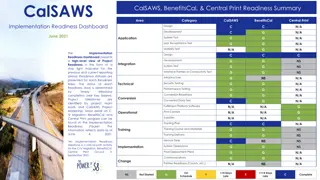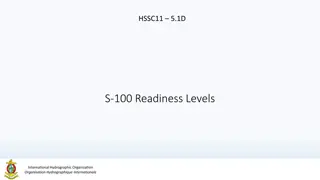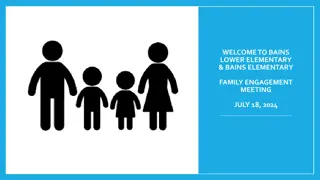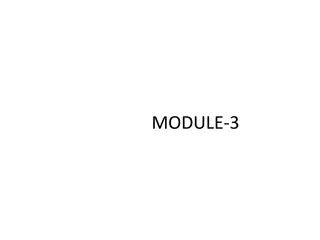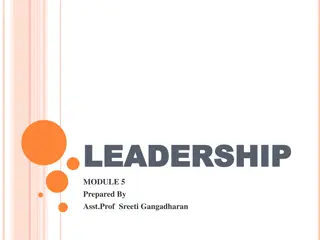Impact of Situational Leadership Readiness in Elementary School
The study explores how situational leadership styles, specifically in the dimensions of Selling, Telling, Participating, and Delegating, impact elementary school leadership. Research conducted at an elementary school in Ciniru, Kuningan, relied on qualitative methods including observation, interviews, and documentation analysis. Findings indicate the importance of adapting leadership styles to meet the needs of teachers and staff in various situations.
Download Presentation

Please find below an Image/Link to download the presentation.
The content on the website is provided AS IS for your information and personal use only. It may not be sold, licensed, or shared on other websites without obtaining consent from the author.If you encounter any issues during the download, it is possible that the publisher has removed the file from their server.
You are allowed to download the files provided on this website for personal or commercial use, subject to the condition that they are used lawfully. All files are the property of their respective owners.
The content on the website is provided AS IS for your information and personal use only. It may not be sold, licensed, or shared on other websites without obtaining consent from the author.
E N D
Presentation Transcript
Situational Leadership Readiness : the Impact of 4th Dimensions in elementary school Teguh Wendy Arisman1 teguhwendy1@gmail.com Eka Prihatin2 ekaprihatin@upi.edu
INTRODUCTION In carrying out his duties and functions, the principal has a distinctive character or style. The situational leadership style can help the principal overcome the problems that occur with the circumstances being experienced by the teacher or staff. This means that the principal adjusts to the problems being experienced by the teacher or staff.
LITERATURE REVIEW The situational leadership approach (Hersey and Blanchard 1969, Blanchard et al. 2013) opinions that to be an effective leader must adapt his leadership style to meet the abilities and needs of their followers and characterize leadership as having direction and supporting components and respectively and should be applied to some degree depending on the situation
There are four styles of situational leadership according to Hersey and Blanchard (1988)
Hersey and Blanchard (Thoha, 1996) are identified in 4 dimensions Selling Telling Participating Delegating
RESEARCH METHODOLOGY This research was conducted at elementary school 1 Ciniru, Kuningan. This research used a qualitative research with descriptive case study. The subject of this research is sample based. This research used several methods, including observation, interviews, and documentation. to analyze the data the researcher conducted: data reduction; data display; conclusions drawing and verification.
Interview finding Observation finding Documentation finding Telling Before giving the assignment the principal gave the instruction Research Finding The principal gave clear directions to his followers before work or doing a task The existence of standard operating procedures for carried out a task Selling Teachers or staff are given the opportunity to express their opinions to the principal The principal gave rewards to teachers' achievement whether in intensive or kind of gift Participating The principal joined in activities related to community members In a meeting, all those who attended the meeting may express their opinions, criticisms, or suggestions some trophies and items are given by the principal of the achievements in sports The school principal participated in public service in making toilets in schools Photos of principals and members during public service activities in the construction of toilets in schools Delegating The principal assigns full responsibility to members who were given certain tasks to complete them The principal chooses a teacher to attend the meeting to represent him Letter of assignment to the teacher to attend a meeting at the Ciniru official office
Discussion Based on the research results, it can be seen that the principal has implemented situational leadership, it can be seen that the role of the principal as telling, selling, paticipating, and delegating. Based on the results of the study, the supporting factors for the implementation of situational leadership are the principal always stakeholders, directs and motivates his members when carrying out work, as well as the availability of adequate facilities and infrastructure to assist the learning process. Meanwhile, the occupying factor is that there are still teachers who are difficult to given direction and cooperating. So that in doing the task is not optimal and not as expected. tries to embrace all
Conclusion Based on the results and discussion, the conclusions in this study are: The implementation of the situational leadership style of elementary school 1 Cinuru's principal, Kuningan has been implemented properly. With various supporting and inhibiting factors, it still produces results as expected so that the school gets accreditation "A" and becomes a sequential school in Ciniru District, Kuningan.





